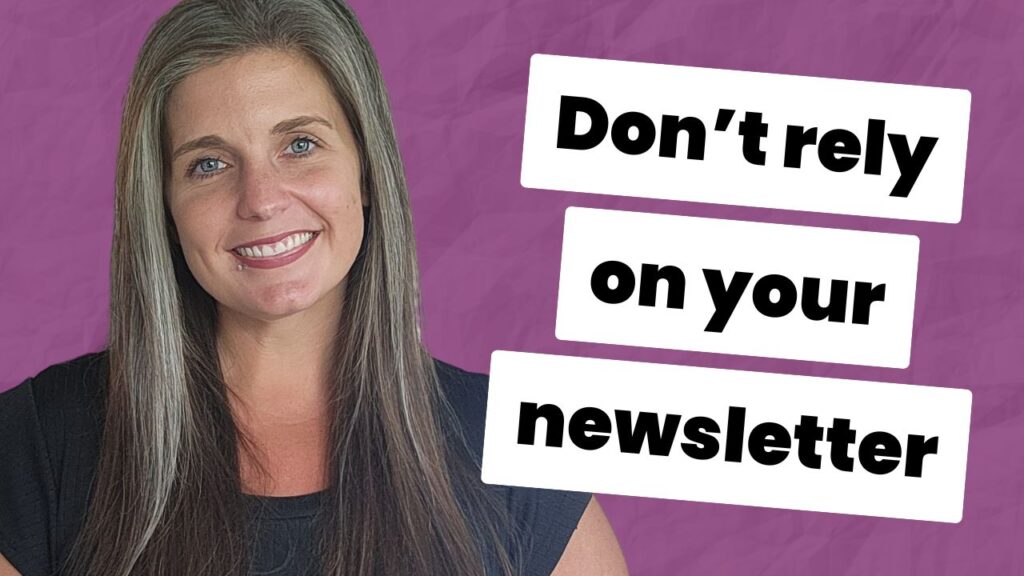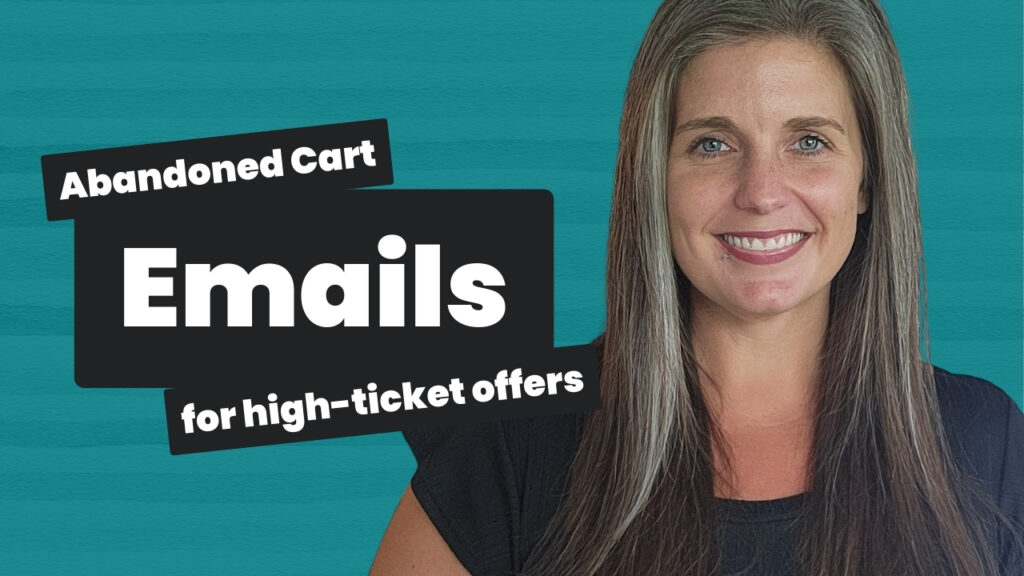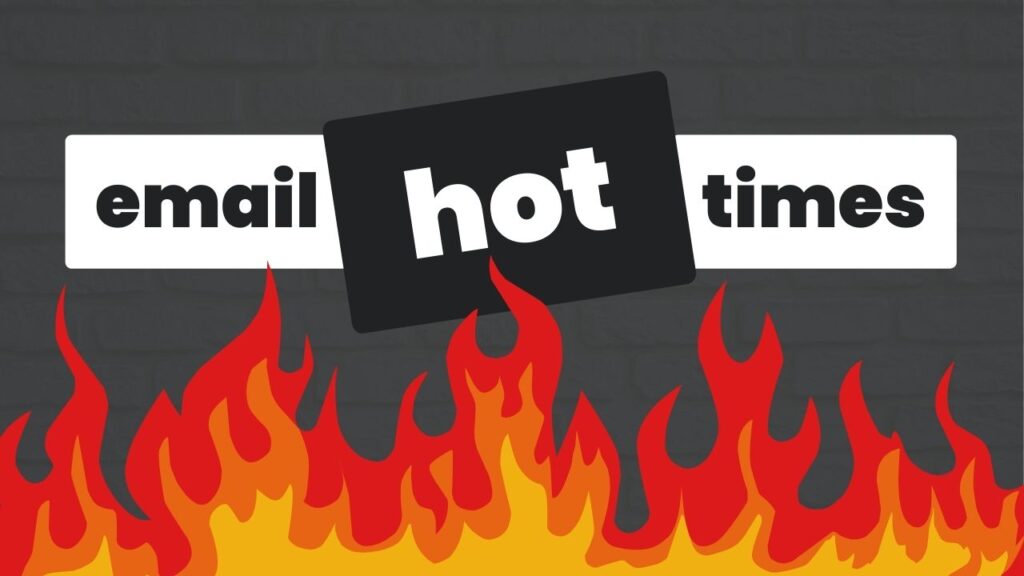I recently did an analysis of all the email campaigns I sent over the last quarter.
Specifically, I was interested in open rates and click-through rates to see what emails worked, what didn’t, and where new opportunities could be.
If you’re new to email marketing:
Open rate is the percentage of your list that opens an email. Click-through rate (or CTR for short) is the percentage of people who click the link inside the email.
They matter because…
A higher open rate means a higher percentage of people are exposed to your sales message. A higher CTR means a higher percentage of people get to your sales or checkout page.
In other words, you want high open rates and CTRs because you want the most people possible exposed to what you’re selling.
Okay, back to the story.
Like I was saying, I’ve been analyzing my open rates and CTRs. I was quite surprised by what I found:
As of mid-October 2018:
My average open rate for newsletters (i.e. one-off emails sent weekly) was 46.64% to my whole list. That means nearly 1 of 2 people open my emails.
My average CTR was 13.45%. That means 13 out of 100 click through to see what I’m offering.
My average unsubscribe rate was 0.51%, which shows very few people are unsubscribing.
The open rates and CTRs were much higher than I expected for one-off newsletters to the entire list.
(There’s always room for improvement.)
That’s great because it means, when I promo something to my list, more people are going to be exposed to it, which should translate to higher sales numbers.
A solid open rate and CTR tells me a few things:
I’m building a list with the right people, and I’m sending stuff they care about.
When it comes to getting higher open rates and CTRs, it’s not just the copywriting that’s important.
In fact, there are 2 really important elements that impact how well your copy performs.
The most important factor is the email list itself. Am I speaking to the right people? The second factor is the offer. Am I sending them stuff they care about? The third factor is the copy. Am I communicating this in the right way?
In this article, I’m going to focus on the “list” level.
Getting the “list” part right can have the biggest impact on your open rates and CTRs — even when using the same copy.
You see…
You can send the exact email to two different lists and get a completely different response.
That’s because not all subscribers are created equal. You want to build a specific, relevant list of people who are interested in the topics around what you sell.
Being a strategic funnel nerd, this is something I do pretty well. And it’s paying off when I send emails.
If you want to get more relevant people on your list, start with your lead magnets.
Your lead magnet (specifically, the title of your lead magnet) is an important indicator of what a subscriber is interested in.
I always advise creating lead magnets that are closely tied to what you’re eventually going to sell either…
by topic/keyword
by pain point/problem
by goals/outcome
When you use lead magnets this way, you’re effectively pre-qualifying subscribers by interest:
Are they interested in this specific topic?
Are they interested in solving this specific problem?
Are they interested in achieving this specific outcome?
I also take it one step further and call out the specific customer avatar I wanting to attract.
Do you sell to course creators? Designers? Women who hate exercising?
Make sure those people know you’re talking to them.
By pre-qualifying by interest and by avatar, you’re building an email list of potential buyers, of somewhat qualified leads, not just subscribers.
After all, you’re paying for the subscribers on your list, so you want them to be people who would be a good fit for your products and/or services.
Here are a few real-world examples of how I’m using lead magnet topics to build a more relevant list of potential buyers in my business:
Example 1: The Funnel Hacks Newsletter
No one wants another newsletter.
They want what’s inside.
So if you’re still asking people to subscribe to your newsletter, this is your easiest opportunity.
At the end of the day, a “newsletter” is a container. It’s a regular email with some sort of info inside. In other words, the term “newsletter” tells us nothing about the value a subscriber gets.
Odds are, like me, you use your newsletter to share free, helpful content.
In that case, all you need to do is re-position (or reword) the title of your newsletter to be focused on what a subscriber gets out of signing up.
Here’s how I’ve done that with the Funnel Hacks Newsletter:
Get free funnel hacks 2-4 times a month – The (mostly) weekly newsletter
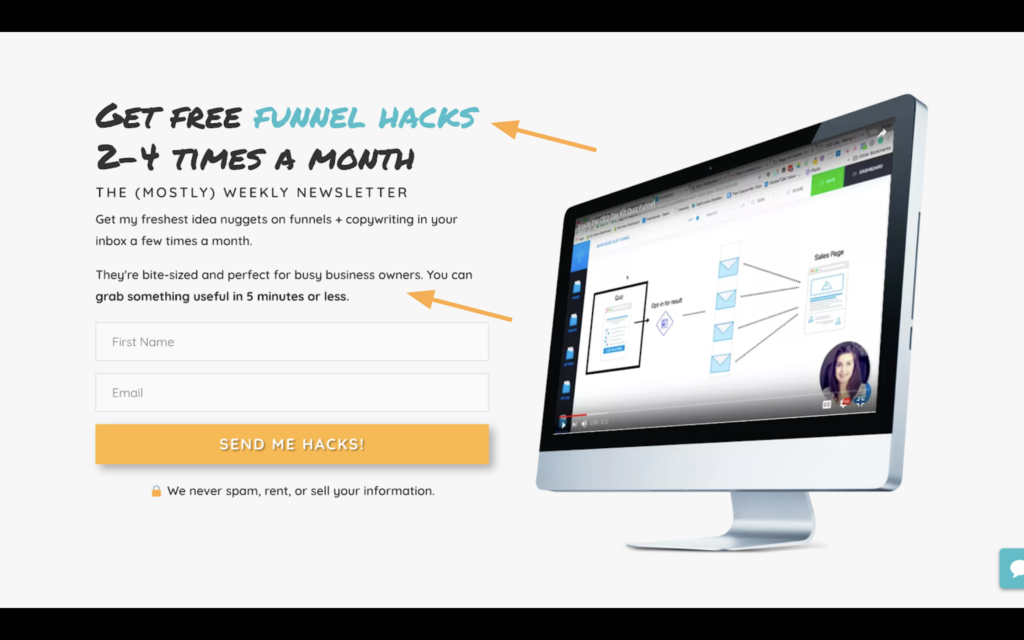
Notice:
I’m using “funnels” as an important keyword since that’s closely tied to what I sell. I could take this up a notch by also being more specific with the problem solved or outcome achieved.
I’m calling out “busy business owners” – which was my not-so-niched niche the last time I updated this opt-in page. Admittedly, I could niche down more with this on the next version of this landing page.
Example 2: The Funnel Tools Masterlist
The Funnel Tools Masterlist is a PDF (e-guide) download. The PDF download part isn’t as important as the message I’m using to communicate the lead magnet:
Grab the 13 tools you need for a funnel that sells courses, coaching, or online services
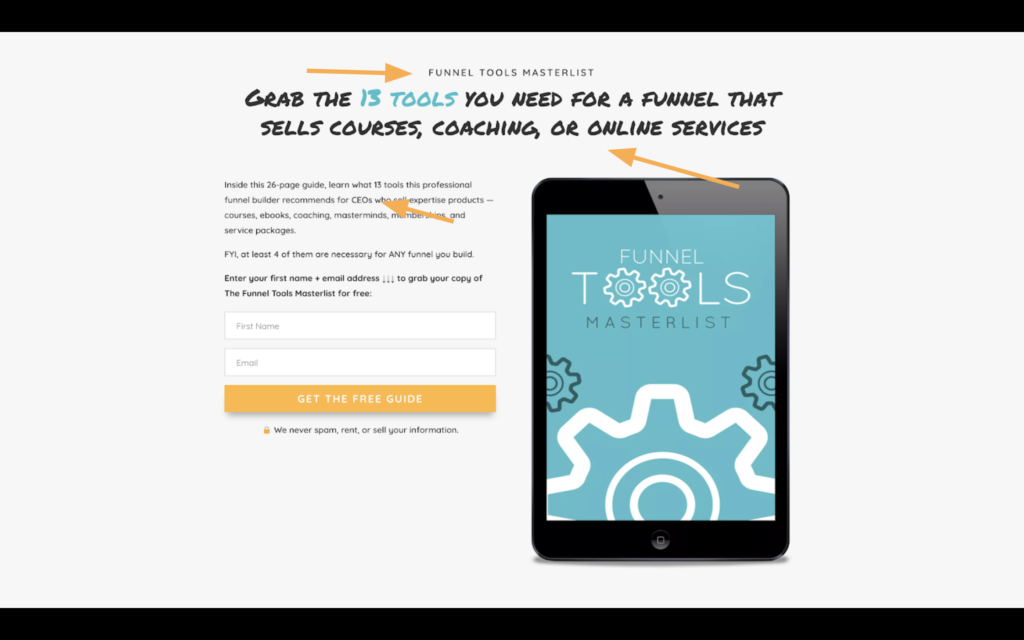
Notice:
I’m using more specific terms this time. “Funnel” and “tools” are used to attract people who are interested in the technical side of funnels for when I launch digital products and affiliate stuff related specifically to tools, software, and technical setup.
I’m being more specific with my ideal customer, i.e. CEOs who sell courses, coaching, and/or online services. This lead magnet is more niched than the newsletter example. But still, there’s room for niching down even more.
Example 3: The Sales Page Checklist
The Sales Page Checklist is a bit different. Yeah, it’s a PDF download, just like the previous example. But I created this lead magnet to sell a specific productized service (i.e. sales page reviews). Whereas, the others were created for a general service category (i.e. funnels).
The headline on a previous version of the landing page reads:
Outline a sales page that’s engineered for power, persuasion, and conversions
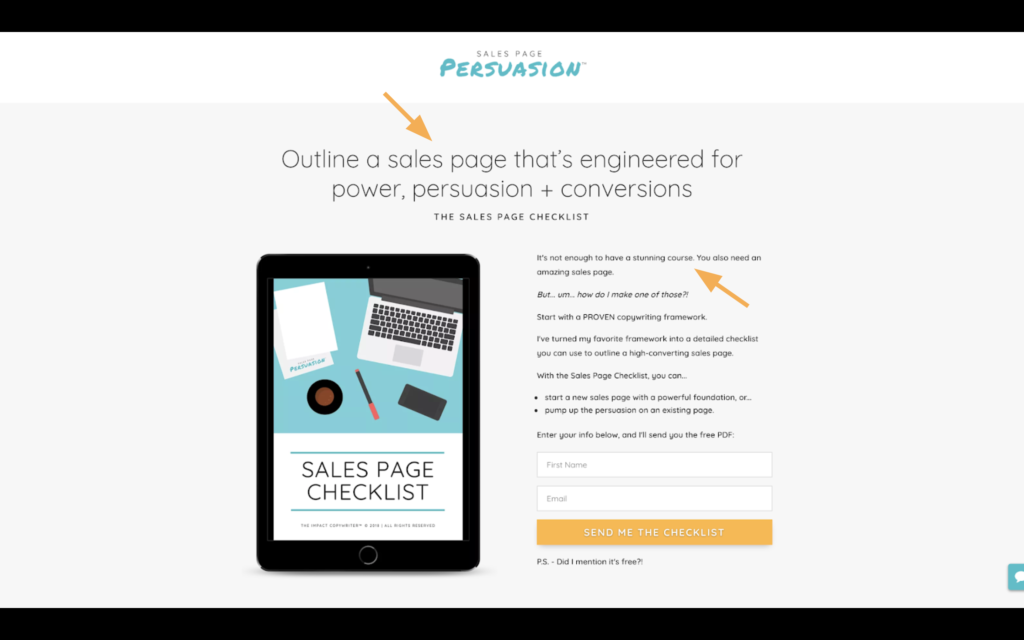
Notice:
I’m already branding this page a bit differently. There’s a logo at the top of the page specific to the service I’m going to sell later on.
I’m using the keyword “sales page”, so I can attract people who are already interested in, want, or have sales pages.
I’ve gone even more niche to focus specifically on course creators (in the body copy, not the headline).
Here’s how you can use these same tactics to revamp your lead magnets
… and start building a more relevant email list:
Step 1: Start with the end goal.
It’s easier to create more strategic lead magnets when you know what you’re selling.
I recommend picking a specific product or service and build backward. For example, if you’re selling Facebook advertising services for graphic designers, create a lead magnet about Facebook ads for graphic designers.
It’s really pretty straightforward.
Your starting point might be:
a specific online course
a specific productized service
a specific service category
a specific coaching package
Notice the word I keep repeating here is specific.
If you’re stuck, brainstorm answers to this question:
I want to sell more ______.
BONUS TIP! I like to sync up the lead magnets I create with quarterly goals. For example, for Q4, I’m focused on selling sales page reviews, so I created the Sales Page Checklist.
Step 2: Choose your WHO.
The more specific you are with who your lead magnet is made for, the better it will resonate. It’ll also be much easier to research, create a compelling headline, and shape on the content if you’re being specific.
Niching is scary. I get it.
Remember, you don’t have to revamp your entire business. Just create specific lead magnets for each customer group you serve.
Step 3: Find out what your target customers are actually struggling with, asking about, or looking to accomplish.
No, you can’t just assume.
Assumptions are risky — and often wrong.
Go out in the digital wild and find out what your best prospects’ and customers’ real experiences are. Interview your past customers and clients. Survey your list. Or dive through Facebook groups and online forums.
My absolute favorite technique is forum mining.
For my business, at least, the best place to mine for data is in Facebook groups and subreddits. I’m looking for conversations around specific keywords (e.g. sales pages).
What are they struggling with? What questions are they asking?
Those insights will help you shape the topic and content of your lead magnet.
Where you’ll go to look for “voice of customer” data depends on where your customers are hanging out and having conversations online.
Step 4: Create your lead magnet.
Now that you’ve got a topic and a general idea of the content. You sit down and build it.
A great question I keep in mind as I mold my lead magnet content is this:
How can I use this lead magnet to make the subscriber a better potential customer?
If there’s prep work a customer or client needs to do before they can work or buy from you, then you’ll want to use your lead magnet to help them get there.
For example, for someone to be a good candidate for my sales page review service, they need to have an existing sales page for me to review. Obviously. Any lead magnet I create should help them get to a completed sales page.
In other words, you can use your lead magnet to create better customers.
When it comes to building the lead magnet, I like to book 3-4 uninterrupted hours to knock out the lead magnet creation in one go. I use Canva to create PDFs ranging from 1 to 5ish pages. For longer PDFs, I might use Pages/Microsoft Word or Keynote/Powerpoint.
Always remember to create a valuable resource that your potential customers can actually use. A disappointing lead magnet only hurts your brand. And it definitely doesn’t inspire new subscribers to trust you to solve their problems.
Step 5: Build a minimum viable funnel.
Every lead magnet is a test.
You want to validate that people want this lead magnet before you invest energy, time, and money into building a more complex funnel.
When I first put out a new lead magnet, I only build a minimum viable funnel, i.e. the least amount of funnel you need to make that lead magnet work.
An MVFunnel consists of the lead magnet download, an opt-in page, a thank you page, and an automated delivery email
Once you have enough validation for your lead magnet, you can add additional emails and link to next-step micro funnels (e.g. a webinar).
If you’re going to invest so much energy, time, and money into list building, shouldn’t you focus on attracting the best potential buyers?
Of course, you should be.
I’ve just walked you through a simple process that’ll help you pre-qualify leads using lead magnets. This is the exact process that’s contributed to my average 46.64% open rate, 13.45% CTR, and 0.51% unsubscribe rate.
By using the techniques and tactics outlined here, you’ll be able to build a more relevant email list, i.e. potential buyers, not just subscribers. Thanks to a more relevant email list, you’re likely to enjoy higher open rates and CTRs — even without changing the copy.
And if you do optimize your subject lines and email copy, those boosts are likely to increase even more.
Higher open rates and CTRs are just a means to an end — indicators that we’re sending the right stuff to the right people in just the right way. The end goal is to generate more sales from our email marketing efforts.
It all starts with the list you build and the lead magnets you use to build it.
